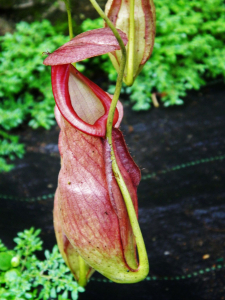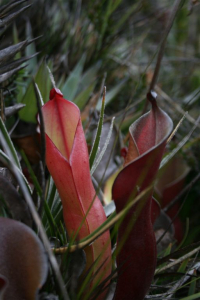Pitcher plant

Pitcher plants are carnivorous plants that have modified leaf forms fused into tubular shapes known as pitchers. The pitchers attract and trap insects, which then decompose in digestive juices at the bottom of the pitchers. Various mechanisms have been proposed for the capture of insects in different types of pitcher plants, but the creation of a slippery liquid layer on the inside of the pitchers is of key importance.
The rims of Nepenthes pitcher plants are characterised by regular microstructures with radial ridges. Water, aided by the addition of nectar, will fill the spaces in the texture to form a continuous highly wettable (superhydrophilic) film. Insects such as ants that have soft adhesive pads on their feet can’t adhere to the liquid layer, meaning that they can’t escape. Oils on the insect feet that usually help adhesion make the situation worse in these pitcher plants, such that most ants that enter the pitcher become trapped in humid weather. This is illustrated in the video below.
In the first half of the video, the inner surface of the pitcher is dry. Ants can easily walk in and out of the pitcher. In the second half, the pitcher is wet. This time, it is clear that ants can’t escape.
Some Nepenthes pitchers have a waxy zone with crystals protruding from the surface which further impede attachment. However, not all Nepenthes pitchers have this zone, so clearly this isn’t the only mechanism at play.
As we have seen in the previous examples, plant hairs (trichomes) usually make plant leaves water-repellant (superhydrophobic). However, pitchers of Heliamphora nutans have inward-pointing hairs that provide a mechanism for creating a highly wettable surface.
Researchers have used the same principles as those employed by pitcher plants to create artificial water-shedding surfaces that are very slippery to most things.

Publications
- Insect aquaplaning: Nepenthes pitcher plants capture prey with the peristome, a fully wettable water-lubricated anisotropic surface, H.F. Bohn and W. Federle, PNAS 101 (2004) 14138-14143.
- ‘Insect aquaplaning’ on a superhydrophilic hairy surface: how Heliamphora nutans Benth. pitcher plants capture prey, U. Bauer, M. Scharmann, J. Skepper and W. Federle, Proc. R. Soc. B. 280 (2013), 20122569. See also the website of the Wong Laboratory for Nature Inspired Engineering.
